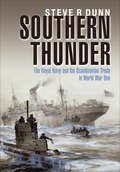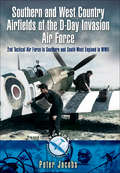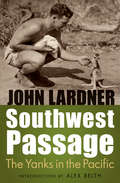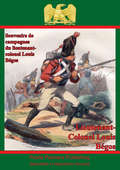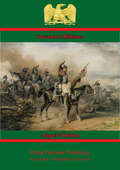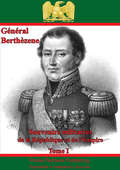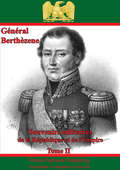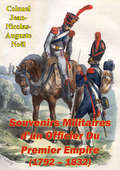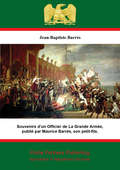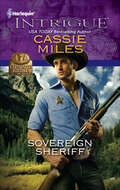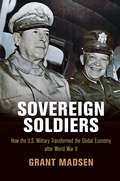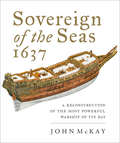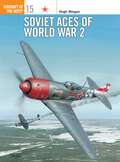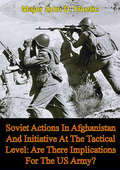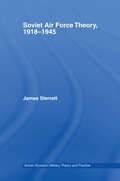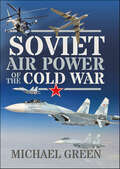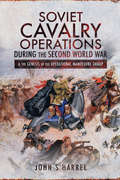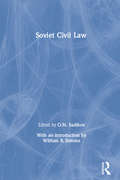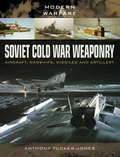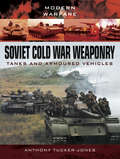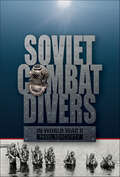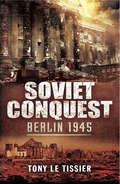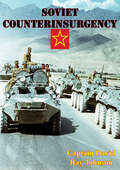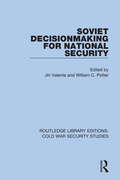- Table View
- List View
Southern Thunder: The Royal Navy and the Scandinavian Trade in World War One
by Steve R DunnA history and analysis of the battle for the North Sea—and the crucial supplies needed by both Britain and Germany to fight the war. During World War I, the Scandinavian countries played a dangerous and sometimes questionable game; they proclaimed their neutrality but at the same time pit the two warring sides against one another to protect their import and export trades. Germany relied on Sweden, Norway, and Denmark for food and raw materials—while Britain needed to restrict the flow of these goods and claim them for herself. And so the battle for the North Sea began. The campaign was ferociously fought, with the Royal Navy forced to develop new tactical thinking, including convoy, to combat the U-boat threat. Many parts of Scandinavia considered that the war had missed the region, and that it was just a distant &“southern thunder.&” Much of that thunder was over the North Sea. This new book tells this little-known, and often ignored, story from both a naval and a political standpoint, revealing how each country, including the USA, tried to balance the needs of diplomacy with the necessities of naval warfare. From the declaration of a British blockade to delicate negotiations, the work of Royal Navy and merchant marine sailors to Admiralty infighting over the development of a new system of convoyed vessels, this book tells the story—including a tense encounter between the US Navy and the German High Sea Fleet—and includes detailed analysis and firsthand accounts of those who were there.
Southern and West Country Airfields of the D-Day Invasion Air Force: 2nd Tactical Air Force in Southern and South-West England in WWII (Aviation Heritage Trail)
by Peter Jacobs"As part of the Aviation Heritage Trail series, the airfields and interest in this book are concentrated in a particular area in this case West Sussex, Hampshire, Dorset, Wiltshire and Cornwall. The South and South-west of England emerged from six years of war with a rich diversity of RAF bomber and fighter airfields used by the 2nd Tactical Air Force, both before and after the D-Day landings. Much of this proud legacy is now threatening to disappear. However, the tourist can combine visits to an abundance of disused and active airfields, country houses and museums with countless attractions, imaginative locations, broad land, and coastal hideaways that have no equal.The airfields and other places of interest include Hartford Bridge, Lasham, Westhamptonett, Merston, Odiham, Holmsley South, Funtington, Hurn, Ford, Tangmere, Ibsley, Perranporth, Thruxton, Thorney Island, Appledram, Selesy, Needs Oar Point, Zeals, Lee-on-Solent and Bognor Regis. This book looks at the history and personalities associated with each base, what remains today and explores the favorite local wartime haunts where aircrew and ground crew would have sought well-deserved entertainment and relaxation. Other museums and places that are relevant will also be described and general directions on how to get them included."
Southwest Passage: The Yanks in the Pacific
by Alex Belth John LardnerAt a time when few Americans had visited Australia, journalist John Lardner sailed down under with the U.S. armed forces as one of the first American war correspondents in the Pacific theater. With his excellent sense of humor and gift for narrative, Lardner penned vignettes of MacArthur’s arrival and his reception in Melbourne and a flight with the daring Dutch flier Capt. Hans Smits. More frequently, Lardner wrote about the ordinary day and the average person. Traveling throughout the country, in Southwest Passage Lardner offers a glimpse of Australia in the 1940s and generates warmth and admiration for World War II fighters in the Pacific, whether Australian, New Zealander, aboriginal, or American. For generations of readers who have learned about World War II with the benefit of hindsight, Lardner’s tone, style, and selected topics give more than just entertaining anecdotes about the military in the Pacific; they are a view into the culture and society of midcentury America.
Souvenir
by James R. BennAn American soldier&’s life, from the Depression to WWII and the turbulent 1960s, is told through memory—and a dangerous secret. Secrets trail an American soldier from his Depression upbringing to the cold winter battles in the Ardennes Forest in the last months of World War II, and through the postwar decades, as he struggles to keep his family from being torn apart while keeping the truth buried close to his heart. Clay Brock, proprietor of Jake&’s Tavern, has endured terrible losses throughout his life. In 1964, he is working to build a life for his wife and son, only to see everything he has worked for threatened by forces beyond his control. To keep his family from breaking apart, he must confront the very secret he has kept buried. For Clay, the war has never been over, and his foxhole buddy Jake Burnett never far from his thoughts. At two crucial points in his life, as a young father and later as an old man at the dawn of a new and unfamiliar century, his memories draw him back until he must confront them and speak the truth. But at what cost?
Souvenirs De Campagnes Du Lieutenant-Colonel Louis Bégos
by Lieutenant-Colonel Louis Bégos« Souvenirs de campagnes du lieutenant-colonel Louis Bégos, ancien capitaine adjudant-major au 20 régiment suisse au service de la France. Lausanne, Delafontaine, 1859, in-8°, 188 p.Bégos a voulu par réaction contre Thiers qu'il accuse d'avoir oublié le rôle des soldats suisses, dans les armées napoléoniennes, raconter sa participation aux opérations militaires en Italie, en Espagne et en Russie. » p 14 - Professeur Jean Tulard, Bibliographie Critique Des Mémoires Sur Le Consulat Et L'Empire, Droz, Genève, 1971
Souvenirs Militaires
by Auguste ThirionThis ebook is purpose built and is proof-read and re-type set from the original to provide an outstanding experience of reflowing text for an ebook reader. « Scènes pittoresques de bivouacs ou de batailles, intéressant les campagnes de Pologne, d'Espagne, de Russie et d'Allemagne et s'achevant sur le portrait de Marmont que le justifie. » p 163 - Professeur Jean Tulard, Bibliographie Critique Des Mémoires Sur Le Consulat Et L'Empire, Droz, Genève, 1971 Auguste Thirion (1787-1869)
Souvenirs Militaires De La République Et De l’Empire Tome I (Souvenirs Militaires De La République Et De l’Empire #1)
by Général Baron Pierre Berthezène« Souvenirs militaires de la République et de l'Empire. Paris, Dumaine, 1855, 2 vol. in-8°. Portr.Bon récit de la seconde campagne d'Italie (pp. 85-108) et surtout des opérations en Prusse et de l'occupation du pays : recensement des ressources (donations, problème de la monnaie... (pp. 111-168). Nombreux détails, mais des inexactitudes, sur la campagne d'Autriche (pp. 169-270), l'expédition d'Anvers (pp. 273-283). La guerre en Russie occupe les dernières pages du tome I et le début du tome II. La campagne de 1813 est également racontée de façon détaillée. A peu près rien en revanche sur la campagne de France. Les souvenirs s'achèvent sur les opérations de 1815. C'est par cette partie que Berthezène avait commencé la rédaction de ses mémoires en 1816. Malgré quelques erreurs, il a l'avantage sur d'autres généraux, de s'attacher à décrire les pays occupés ou envahis. » p 16 - Professeur Jean Tulard, Bibliographie Critique Des Mémoires Sur Le Consulat Et L'Empire, Droz, Genève, 1971
Souvenirs Militaires De La République Et De l’Empire Tome II (Souvenirs Militaires De La République Et De l’Empire #2)
by Général Baron Pierre Berthezène« Souvenirs militaires de la République et de l'Empire. Paris, Dumaine, 1855, 2 vol. in-8°. Portr.Bon récit de la seconde campagne d'Italie (pp. 85-108) et surtout des opérations en Prusse et de l'occupation du pays : recensement des ressources (donations, problème de la monnaie... (pp. 111-168). Nombreux détails, mais des inexactitudes, sur la campagne d'Autriche (pp. 169-270), l'expédition d'Anvers (pp. 273-283). La guerre en Russie occupe les dernières pages du tome I et le début du tome II. La campagne de 1813 est également racontée de façon détaillée. A peu près rien en revanche sur la campagne de France. Les souvenirs s'achèvent sur les opérations de 1815. C'est par cette partie que Berthezène avait commencé la rédaction de ses mémoires en 1816. Malgré quelques erreurs, il a l'avantage sur d'autres généraux, de s'attacher à décrire les pays occupés ou envahis. » p 16 - Professeur Jean Tulard, Bibliographie Critique Des Mémoires Sur Le Consulat Et L'Empire, Droz, Genève, 1971
Souvenirs Militaires d’un Officier Du Premier Empire (1792 – #1832)
by Colonel Jean-Nicolas-Auguste Noël« Le colonel Noël a participé à la seconde campagne d'Italie, celle de 1809, sous les ordres de Macdonald (récit des batailles de la Piave, Tarvis, Raab), à l'expédition d'Espagne et du Portugal (Ciudad-Rodrigo, Torres-Vedras), aux campagnes de Russie, d'Allemagne et de France, à Waterloo enfin. Il a consigné impressions sur des carnets dont l'éditeur n'a publié que les récits militaires, coupant les réflexions d'ordre moral ou politique ce qui est dommage. A noter la critique adressée à Napoléon de n'être pas revenu en Espagne en 1810 pour prendre lui-même en main les opérations. » p 122-123 - Professeur Jean Tulard, Bibliographie Critique Sur Des Mémoires Sur Le Consulat Et L'Empire, Droz, Genève, 1971
Souvenirs d’un Officier de La Grande Armée,: publié par Maurice Barrès, son petit-fils.
by Maurice Barrès Jean-Baptiste Barrès« Souvenirs d'un Officier de La Grande Armée, publié par Maurice Barrés, son petit-fils. Paris Plon, 1923, in-16, 332 p... Maurice Barrés a bien mis en lumière dans sa préface ce qu'il y a de naïf et de savoureux dans ces souvenirs de son grand-père, vélite de la Garde. On Lira avec amusement le récit du sacre, celui d'Austerlitz et sa célèbre veillée, l'entrevue de Tilsit, la nomination au grade de sous-lieutenant, le Portugal en 1810, la campagne d'Allemagne... » p 11 - Professeur Jean Tulard, Bibliographie Critique Des Mémoires Sur Le Consulat Et L'Empire, Droz, Genève, 1971
Sovereign Sheriff (Cowboys Royale #5)
by Cassie MilesAs sheriff, the law guided his decisions.As a man protecting a princess, his libido seemed to be in control...Sheriff Jake Wolf took pride in two things: his Native American heritage and his adherence to the law. So when Princess Saida Khalid came to him, desperate for answers to an unsolved case, Jake stuck to the facts-and tried not to get distracted by what he wanted. But ignoring Saida's gorgeous features and whip-smart mind were nearly impossible, especially when she claimed he was the only person who could keep her safe. Jake had every intention of maintaining a professional distance...even though he ached to hold her and promise everything would be okay. But remaining alert had to be his priority. And one touch would never be enough.
Sovereign Soldiers: How the U.S. Military Transformed the Global Economy After World War II (American Business, Politics, and Society)
by Grant MadsenThey helped conquer the greatest armies ever assembled. Yet no sooner had they tasted victory after World War II than American generals suddenly found themselves governing their former enemies, devising domestic policy and making critical economic decisions for people they had just defeated in battle. In postwar Germany and Japan, this authority fell into the hands of Dwight D. Eisenhower and Douglas MacArthur, along with a cadre of military officials like Lucius Clay and the Detroit banker Joseph Dodge.In Sovereign Soldiers, Grant Madsen tells the story of how this cast of characters assumed an unfamiliar and often untold policymaking role. Seeking to avoid the harsh punishments meted out after World War I, military leaders believed they had to rebuild and rehabilitate their former enemies; if they failed they might cause an even deadlier World War III. Although they knew economic recovery would be critical in their effort, none was schooled in economics. Beyond their hopes, they managed to rebuild not only their former enemies but the entire western economy during the early Cold War.Madsen shows how army leaders learned from the people they governed, drawing expertise that they ultimately brought back to the United States during the Eisenhower Administration in 1953. Sovereign Soldiers thus traces the circulation of economic ideas around the globe and back to the United States, with the American military at the helm.
Sovereign of the Seas, 1637: A Reconstruction of the Most Powerful Warship of Its Day
by John McKay“McKay’s artful renderings provide a fitting tribute to this amazing vessel and those who participated in her planning and construction.” —Pirates and PrivateersSovereign of the Seas was the most spectacular, extravagant and controversial warship of the early seventeenth century. The ultimate royal prestige project, whose armament was increased by the King’s decree to the unheard-of figure of 100 guns, the ship finally cost the equivalent of ten more conventional warships. A significant proportion of this total was spent on her gilded decoration, which gave the ship a unique combination of firepower and visual impact in battle that led her Dutch opponents to dub her the “Golden Devil.” It is unsurprising that such a high-profile ship should be well-documented, but there are no contemporary plans and much of the visual evidence is contradictory. In this book, John McKay sets out to analyze the data and reconstruct the design and appearance of the ship in a degree of detail never previously attempted. The results are presented as a folio of superbly drafted plans, isometric drawings and colored renderings, covering every aspect of the design from the hull form to the minutiae of sails and rigging. Each section is accompanied by an explanatory text, setting out the rationale for his conclusions, so the book will be of value to historians of the period as well as providing superb reference for any modeler tackling of one of the most popular of all sailing ship subjects.“A magnificent book on a magnificent ship.” —Nautical Research Journal“Very few books of warships contain the level of detail provided here.” —Firetrench
Soviet Aces of World War 2
by John Weal Hugh MorganNo single volume in English has ever appeared in the West dealing with this intriguing subject area, but now that restrictions have relaxed in the former Soviet Union, records of the deeds of the elite pilots of the various Soviet Air Forces are coming to light. Although initially equipped with very poor aircraft, and robbed of effective leadership thanks as much to Stalin's purges in the late 1930s as to the efforts of the Luftwaffe, Soviet fighter pilots soon turned the tables through the use of both lend-lease aircraft like the Hurricane, Spitfire, P-39 and P-40, and home-grown machines like the MiG-3, LaGG-3/5, Lavochkin La-5/7/9 and the Yak-1/3.
Soviet Actions In Afghanistan And Initiative At The Tactical Level: Are There Implications For The US Army?
by Major John D. FrketicThis monograph examines the Soviet experience in Afghanistan (1979-1988) in terms of Soviet Army tactics and organization for combat. Throughout the decade of the 1970's, U.S. perceptions of Soviet ground force tactics stressed a general lack of initiative and flexibility in their military doctrine. In the 1980's a re-evaluation of Soviet thinking occurred which saw greater flexibility at the operational and strategic levels If the experience in Afghanistan has shown that set-piece tactics will not work in all types of warfare, and the Soviets are able to incorporate higher levels of initiative and flexibility into their tactical doctrine, then the U.S. may be required to refocus its training away from the stylized Soviet enemy.This study begins with a background discussion of Soviet historical involvement in Afghanistan to include counter-insurgency experience in their southwestern border area. It then covers the actual invasion and units employed with emphasis on their pre-deployment status and subsequent performance. The following section divides the war into four phases to ease understanding. The monograph subsequently looks at lessons learned and principles reaffirmed from both the Soviet and U.S. perspective. A key feature is the need the Soviets apparently feel for Western style initiative and flexibility at lower command levels (battalion, company and platoon), and how this is inconsistent with their culture and system of command and control.
Soviet Air Force Theory, 1918-1945 (Soviet (Russian) Study of War)
by James SterrettThis new book examines the development of Soviet thinking on the operational employment of their Air Force from 1918 to 1945, using Soviet theoretical writings and contemporary analyses of combat actions.
Soviet Air Power of the Cold War
by Michael Green"...a praiseworthy examination of the evolution of the Soviet air force throughout the Cold War." — Journal of Military HistoryAt the peak of the Cold War in the 1950s the Soviet Union possessed some 12,000 aircraft, making it the largest air force of all the protagonists. By the 1990s this had declined to around 8,000, the reduction largely reflecting the increase in aircraft capability. As well as fighters and bombers, the Soviet inventory included trainers, transports, seaplanes, electronic warfare and ground attack aircraft, as well as an impressive helicopter fleet, notably the Mi-24 ‘Hind’ gunship and the massive Homer transport. The Tu-4 ‘Bull’ was the first Russian nuclear-capable bomber, a copy of the US B-29, which was followed by their range of jet bombers, the Il-28 ‘Beagle’, Tu-16 ‘Badger’ and M-4 ‘Bison’. The prop driven Tu-20 ‘Bear’ and its successors including the Tu-22 ‘Backfire’ and finally the Tu-160 ‘Backfire’, were all formidable. The jet-engined MiG-15 fighter entered service in 1948 and proved itself during the Korean War. The MiG-17, MiG-19 and MiG-21 followed . Ground-attack aircraft included the Su-7 ‘Fitter’ and M-23 ‘Flogger’. The 1970s saw the MiG-25 ‘Foxbat’ interceptor, followed by the MiG-29 ‘Fulcrum’ and Su-27 ‘Flanker’, coming into service. All these aircraft and many more are authoritatively described and vividly illustrated in this comprehensive work.
Soviet Cavalry Operations During the Second World War: & the Genesis of the Operational Manoeuvre Group
by John S. HarrelThe author of The Nisibis War analyzes the Red Army&’s usage of horse-mounted units along the Soviet-German Eastern Front during World War II. While the development of tanks had largely led to the replacement of cavalry in most armies by 1939, the Soviets retained a strong mounted arm. In the terrain and conditions of the Eastern Front, they were able to play an important role denied them elsewhere. John Harrel shows how the Soviets developed a doctrine of deep penetration, using cavalry formations to strike into the Axis rear, disrupting logistics and lines of communication, encircling and isolating units. Interestingly he also shows that this doctrine did not stem from the native cavalry tradition of the steppe but from the example of the American Civil War. The American approach was copied by the Russians in WWI and the Russian Civil War, refined by the Soviets in the early stages of World War Two, and perfected during the last two years of the war. The Soviet experience demonstrated that deep operations (cavalry raids) against enemy rear echelons set the conditions for victory. Although the last horse-mounted units disappeared in the 1950s, their influence led directly to the formation of the Operational Manoeuvre Groups that, ironically, faced U.S. forces in the Cold War. &“An expansive analysis of the technical, tactical and operational employment of Soviet cavalry against the Germans and their Axis allies. For practitioners who want to understand the history and development, the book is a goldmine of overlooked campaigns and actions . . . . The book&’s dense and detailed presentation makes it valuable to operational planners and those interested in the Soviet-German war.&” —ARMOR Magazine
Soviet Civil Law
by O.N. SadikovThis volume is an unabridged translation of the textbook ‘Soviet Civil Law’, originally published in 1983 under the auspices of the USSR Ministry of Justice. Edited by Professor O.N. Sadikov, the work includes contributions from nine Soviet legal scholars
Soviet Cold War Weaponry: Aircraft, Warships And Missiles (Modern Warfare)
by Anthony Tucker-Jones"In this companion volume to his photographic history of Soviet tanks and armoured vehicles, Anthony Tucker-Jones provides a visual guide to the vast array of aircraft, warships and missiles the Soviet armed forces deployed at the height of the Cold War. Although the superpowers never came to blows, the so-called 'Cold War' was far from cold, with numerous 'hot' proxy wars being fought in Africa and the Middle East. All these conflicts employed Soviet weaponry which has been captured in action in the colour and black-and-white photographs selected for this book. Between the 1950s and 1980s Soviet and Warsaw Pact countries churned out thousands of weapons ready for the Third World War. They also embarked on a technological arms race with NATO in an attempt to counter each new piece of equipment as it appeared. The MiG fighters, the Badger and Backfire bombers, the nuclear submarines have achieved almost iconic status, but, as Anthony Tucker-Jones's book shows, there was much more to the Soviet armoury than these famous weapons. Much of it, despite its age, remains in service with armies, guerrilla forces and terrorist organizations around the world today."
Soviet Cold War Weaponry: Tanks and Armoured Vehicles (Modern Warfare)
by Anthony Tucker-JonesThe T-54, T-62 and T-72 main battle tanks along with the personnel carriers, assault guns, self-propelled guns and anti-tank missiles that are illustrated in this photographic history represent the high point in the design and manufacture of armoured vehicles by the Soviet Union during the Cold War. Although the superpowers never came to blows, the 'Cold War' was far from cold, as numerous 'hot' proxy wars were fought in Africa and the Middle East, and these conflicts employed the Soviet weaponry that is shown in action in the colour and black-and-white photographs selected for this book.Between the 1950s and 1980s Soviet and Warsaw Pact countries produced thousands of tanks and armoured vehicles ready for the Third World War. They embarked on a technological arms race with the NATO allies in an attempt to counter each new piece of equipment as it appeared in service. Much of this Soviet weaponry has achieved almost iconic status and, despite its age, remains in service with armies, guerrilla forces and terrorist organizations around the world today. It is also of enduring interest to collectors, re-enactors and modellers who are fascinated by the military equipment of the late twentieth century.
Soviet Combat Divers in World War II
by Pavel BorovikovRare look at the role and place of Soviet combat divers in World War II
Soviet Conquest: Berlin 1945
by Tony Le TissierHow did top Red Army commanders see the assault on Berlin in 1945 what was their experience of the last, terrible battle of the Second World War in Europe? Personal accounts by the most famous generals involved Zhukov, Koniev and Chuikov have been published in English, but the recollections of their principal subordinates haven't been available in the west before, and it is their role in the final Soviet offensive that is the focus of Tony Le Tissier's fascinating book. These were the officers who were responsible for the execution of the Red Army's plan for the assault, in immediate touch with the troops on the front line of the advance. They saw most clearly where the operation succeeded and where it failed. Their recollections, publication of which was long banned in the Soviet Union, throw a new light on the course of battle and on the inner workings of the Red Army command in the final phase of the conflict.
Soviet Counterinsurgency
by Captain David Ray JohnsonThe aim of this paper is to determine the presence or absence of a Soviet doctrine of counterinsurgency and to identify the historical patterns of Soviet counterinsurgency. The development of these central themes should contribute to the secondary goals of the paper; first, to establish a fuller basis of comparison than is currently used in examination of Soviet and Soviet-advised counterinsurgent campaigns, and second, to add some historical depth to the developing body of work on Soviet counterinsurgency. This should allow for some useful generalizations about the Soviet approach to counterinsurgent warfare to be derived.Counterinsurgency became a preoccupation of the U.S. military during the late fifties and early sixties. The U.S. involvement in Vietnam sustained interest in counterinsurgency and new challenges to U.S. interests in Latin America, Asia, and Africa have renewed attention to issues of counterinsurgency in the eighties. Although the insurgents (primarily the Central Asian Basmachi), and comparative surveys of the counterinsurgency campaigns of the Soviets in Afghanistan and various Soviet allies fighting insurgents since 1975. For the purpose of establishing the patterns of Soviet counterinsurgency the limited number of cases in the first two approaches is too narrow. Although the third approach examines more cases, it mixes dissimilar cases and blurs distinctions between Soviet methods of counterinsurgency and the methods of Soviet advised militaries fighting insurgencies.
Soviet Decisionmaking for National Security (Routledge Library Editions: Cold War Security Studies #47)
by Jiri Valenta; William C. PotterThis book, first published in 1984, analyses the critically important Cold War issue of the Soviet national security decision-making process dealing with weapons acquisition, arms control and the application of military force. It conceptualises Soviet decision-making for national security from Stalinist antecedents to 1980s modes, and examines the problems of decision-making concerning weapons development, defence research and development and SALT negotiations. It also focuses on the decision-making processes which led to the use or threatened use of military force in Czechoslovakia (1968), the Middle East (1973) and Afghanistan (1979).
